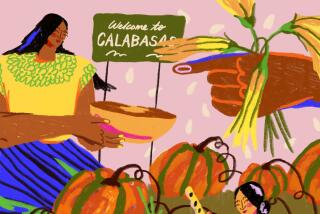Pumpkin Pales by Comparison
- Share via
ZIONSVILLE, Pa. — To find a genuine white pumpkin, you can wind along Sleepy Hollow Road to Spinnerstown, Pa., and follow the narrow, bumpy path to Daniel Schantz’s farm.
There, in a 1 1/2-acre patch tucked between corn fields and cow pastures in Lehigh County, Schantz cultivates a Halloween pumpkin that’s pale as a ghost.
Not yellow or light orange, but bone white--gravestone white.
Introducing “Little Boo,” a strain of pumpkin developed by scientists in the quest for a better--and safer--jack-o’-lantern.
Schantz claims to be the first and only farmer in Pennsylvania to raise Little Boos, and he says these ghostly gourds are selling faster than trick-or-treat candy.
“We’re having no problem getting rid of ‘em,” said Denny Heilman, general manager of the Schantz farm, who plans to expand the crop next year.
Heilman said retailers are willing to shell out 25 cents a pound for his Little Boos, about 10 cents more than they pay for the common variety.
Why a white pumpkin?
The main reason has to do with kids and pumpkins and knives--a frightful combination, as far as most moms are concerned.
“In the last few years, the painted pumpkin is taking precedence over the carved pumpkin because parents don’t want their kids using knives,” said Heilman. “White pumpkins are a lot easier to paint.”
Besides offering a bright background for the young jack-o-lantern artist, the Little Boo is small and manageable--the average diameter is about eight inches. It also has a smooth, hard rind for easy painting, he said.
Unfortunately, however, the value of these new pumpkins is skin deep.
“It’s really more of a jack-o-lantern pumpkin. It’s not bred to be a pie pumpkin,” Heilman said.
Any attempt to eat the green meat of the Little Boo, he warned, might bring on a horror story of a different kind.
More to Read
Sign up for The Wild
We’ll help you find the best places to hike, bike and run, as well as the perfect silent spots for meditation and yoga.
You may occasionally receive promotional content from the Los Angeles Times.





